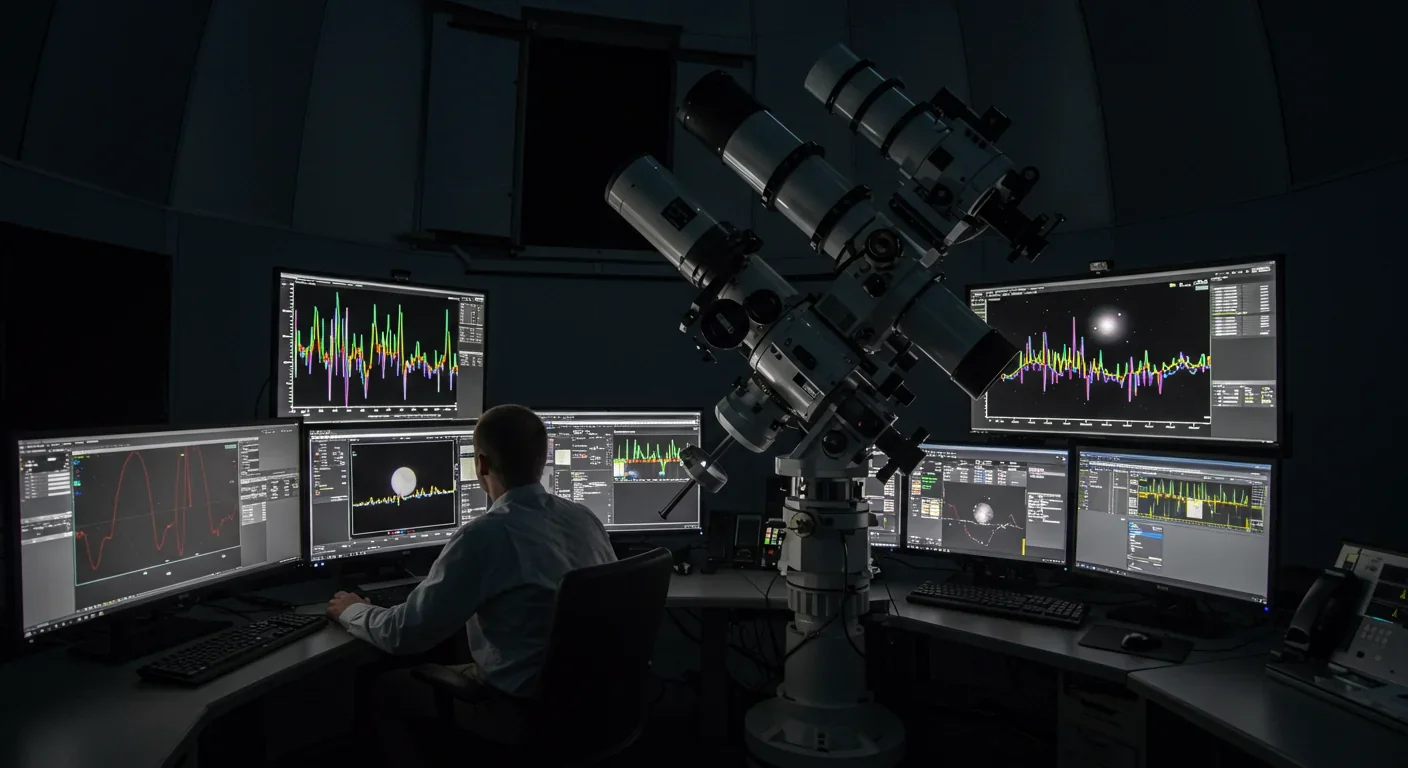Fusion Rockets Could Reach 10% Light Speed: The Breakthrough

TL;DR: Over 80% of nearby white dwarfs show chemical fingerprints of destroyed planets in their atmospheres—cosmic crime scenes where astronomers perform planetary autopsies using spectroscopy. JWST recently discovered 12 debris disks with unprecedented diversity, from glassy silica dust to hidden planetary graveyards invisible to previous surveys. These stellar remnants offer the only direct measurement of exoplanet interiors, revealing Earth-like rocky worlds, Mercury-like metal-rich cores, and even icy Pluto analogs rich in water and nitrogen. In 5 billion years, our Sun will become a white dwarf and consume Earth's remains, leaving spectral fingerprints for alien astronomers to decode—a preview written in the light of thousands of dead stars today.

By 2030, astronomers predict they'll have cataloged the chemical fingerprints of thousands of destroyed planets—worlds torn apart billions of years ago, yet still telling their stories through the contaminated atmospheres of stellar corpses called white dwarfs. This cosmic detective work isn't just about distant systems; it's a preview of our own solar system's violent end, when the Sun will devour its inner planets and shred the outer ones into dust.
What makes white dwarfs such powerful archaeological sites? These Earth-sized embers pack half the Sun's mass into a volume smaller than our planet, creating gravitational forces so extreme that heavy elements should sink out of view within days or months. Yet when astronomers point their telescopes at white dwarfs, they find something astonishing: over 80% of these dead stars within 40 light-years show spectroscopic evidence of recent planetary debris pollution. The math is stark—if metals disappear in months but persist for millions of years of observations, white dwarfs must be continuously fed by a slow rain of shattered worlds.
In January 2025, the James Webb Space Telescope delivered a game-changing discovery that rewrote our understanding of planetary destruction. Observing 36 metal-polluted white dwarfs with its Mid-Infrared Instrument, JWST detected 12 debris disks—a 33% detection rate that dwarfs the 10-15% found by earlier missions. But the real revelation wasn't the quantity; it was the diversity.
Three white dwarfs showed the strongest silicate emission features ever recorded around any star, dead or alive. The spectral signature pointed to amorphous silica—glassy dust forged at temperatures exceeding 2,000 Kelvin, hotter than molten lava. This wasn't the gradual grinding of asteroids; it was evidence of violent, high-energy planetary destruction playing out in real time.
Even more striking, JWST found disks where no disk should exist. Two white dwarfs showed subtle silicate features despite having no detectable infrared excess in standard photometric surveys. The implication sent a shockwave through the planetary science community: current surveys miss most debris disks. Spectroscopy reveals what photometry cannot—meaning astronomers have been observing planetary graveyards for decades without realizing it.
The discovery of 21-micrometer infrared excesses in two polluted white dwarfs opened yet another window. These excesses can't be explained by warm dust alone; they likely trace wide-orbit Jovian planets at 10 astronomical units or beyond—giant worlds that survived their star's red giant phase but now slowly pull smaller bodies inward to their doom.
When astronomers first detected calcium absorption lines in white dwarf spectra in 1917, they dismissed it as a curiosity—perhaps contamination from the interstellar medium. For nearly 70 years, these metal-polluted spectra remained unexplained anomalies in stellar classification schemes. The puzzle deepened when researchers calculated diffusion timescales in the 1980s and realized heavy elements should vanish from white dwarf atmospheres in mere months, not persist across millennia of observations.
The paradigm shift came in 1987, when astronomers discovered an infrared excess around the white dwarf G29-38. The signature matched a warm dust disk, and suddenly the pieces clicked into place: white dwarfs weren't accreting interstellar gas—they were consuming the shattered remnants of their own planetary systems. The spectral lines were planetary autopsy reports, preserved in starlight.
This revelation transformed our approach to exoplanet research. Before white dwarf spectroscopy, astronomers could only infer planetary compositions indirectly—through transit spectroscopy of atmospheres or by modeling stellar metallicities. White dwarfs offered something unprecedented: direct samples of planetary interiors, chemically analyzed with laboratory precision.
The historical parallel is striking. Just as paleontologists reconstruct extinct species from fossilized bones, astronomers now reconstruct destroyed exoplanets from their spectral fingerprints. Both fields require meticulous forensic work, both reveal deep time, and both fundamentally changed how we understand our place in the universe.
Every element in the periodic table absorbs light at unique wavelengths—calcium at 3,968 and 3,934 angstroms, magnesium at 5,167 angstroms, iron across dozens of lines in the visible and ultraviolet. When a white dwarf's intense gravity tears apart an asteroid or dwarf planet that drifts too close, the debris forms a disk within the star's Roche limit—typically just 140 stellar radii for rocky bodies. Tidal forces grind the material into dust, which spirals inward and vaporizes onto the white dwarf's surface at rates reaching 200,000 kilograms per second.
As this planetary material rains down, it contaminates the star's otherwise pure hydrogen or helium atmosphere. High-resolution spectrographs like Keck's HIRES (resolving power 40,000) can then dissect this pollution into individual elemental signatures. The depth of each absorption line reveals abundance; the pattern across elements reconstructs composition.
But there's a catch—one that makes white dwarf spectroscopy as much art as science. Heavy elements don't all sink at the same rate. In a hydrogen-atmosphere white dwarf at 12,660 Kelvin, calcium settles in 35,000 to 120,000 years depending on atmospheric depth, while lighter elements like oxygen sink faster. This differential diffusion means the observed spectrum is a snapshot of a dynamic process, not a static composition. To reconstruct the original planetary body, astronomers must model this sinking mathematically, using exponentially decaying disk models that account for both accretion rate and time since disruption.
The precision is remarkable. A 2024 study of the white dwarf LSPM J0207+3331 measured iron, silicon, magnesium, calcium, titanium, aluminum, sodium, nickel, chromium, and oxygen abundances to within 0.2 dex (a factor of 1.6)—comparable to laboratory analysis of meteorites. The verdict? The destroyed planet had a bulk composition resembling Earth but with a slightly higher core-to-mantle mass fraction, indicating a Mercury-like interior structure.

The elemental ratios measured in polluted white dwarf atmospheres read like cosmic medical records, diagnosing the internal anatomy of long-dead worlds. When astronomers find elevated iron-to-silicon ratios—as in the white dwarf WD J0820—they're seeing evidence of a differentiated planet that had time to separate its metallic core from its rocky mantle before being destroyed. Conversely, near-solar abundance patterns suggest primitive, undifferentiated bodies like carbonaceous chondrites.
The white dwarf GD 362 provides a textbook example. JWST spectroscopy revealed a debris disk dominated by olivine and pyroxene silicate minerals, with elemental abundances matching CI chondrite meteorites to within a factor of two. Aluminum ran slightly high, oxygen slightly low, but the overall composition pointed to a water-poor, rocky asteroid analogous to main-belt bodies in our solar system. The disk's infrared luminosity—a staggering 2.4% of the star's total output—implied a massive disruption event, possibly the tidal shredding of a Ceres-sized dwarf planet.
Then there's the depletion signature—a pattern that echoes Earth's own chemistry. Multiple studies have found that accreted planetary material shows systematic deficits in moderately refractory elements (magnesium, silicon, iron) relative to highly refractory elements (calcium, titanium). This isn't an accident of stellar nucleosynthesis; it's a fingerprint of planetary differentiation and core formation. When a protoplanet melts and separates into core and mantle, iron and nickel preferentially migrate to the core, depleting the mantle in these elements. If a white dwarf then accretes mantle material—perhaps from the outer layers of a tidally disrupted body—the spectrum will show exactly this depletion pattern.
The discovery of strontium in the white dwarf WD J2141+3300 added another puzzle piece. Strontium is trace-element rare, and its detection marked only the third known white dwarf to exhibit it. Its presence hints at complex mineralogy—perhaps the accreted body contained calcium-aluminum-rich inclusions (CAIs), the oldest solids in the solar system, or exotic refractory minerals from high-temperature planetary formation processes.
But the real breakthrough came with volatiles. For decades, white dwarf spectroscopy had focused on rocky, refractory debris because optical spectra easily detect calcium, iron, and magnesium. Detecting water, nitrogen, and carbon required ultraviolet observations—wavelengths accessible only to space-based telescopes. In 2024, Hubble's Cosmic Origins Spectrograph delivered a stunning result: the white dwarf WD 1647+375 showed a nitrogen abundance of approximately 5% by mass and an oxygen excess implying a water-to-rock ratio of 2.45. This wasn't an asteroid—it was an icy dwarf planet, a Pluto analog, with a volatile-rich composition matching Kuiper Belt objects in our own solar system.
The accretion rate—2×10⁸ grams per second over at least 13 years—allowed astronomers to calculate a minimum parent body mass of 10¹⁷ grams, corresponding to an object at least 3 kilometers across, possibly as large as 50 kilometers. The nitrogen mass fraction, the highest ever detected in white dwarf debris, proved that icy planetesimals can survive billions of years in the outer reaches of planetary systems, only to be scattered inward and destroyed once their host star sheds mass and becomes a white dwarf.
White dwarf pollution statistics tell a story of ubiquitous planetary survival—and eventual doom. Within 40 parsecs (130 light-years) of Earth, 81% of hydrogen-atmosphere white dwarfs show detectable photospheric metals. For helium-atmosphere white dwarfs, the fraction is even higher. Extrapolating across the Milky Way's estimated 10 billion white dwarfs, this implies billions of active planetary graveyards scattered throughout the galaxy.
Yet the picture is more nuanced than simple survival rates suggest. High-mass white dwarfs—those above 0.8 solar masses—show dramatically lower pollution fractions. Within 40 parsecs, only one polluted hydrogen-atmosphere white dwarf exceeds 0.8 solar masses: WD J0850+5848, at 1.08 solar masses. This dearth points to a mass-dependent mechanism: either massive progenitor stars (which produce massive white dwarfs) destroy their planetary systems during late stellar evolution, or the shorter diffusion timescales in massive white dwarfs make pollution harder to detect.
Population synthesis models favor the second explanation. A white dwarf's atmospheric diffusion timescale scales inversely with surface gravity—higher mass means stronger gravity and faster sinking. For a 1.2-solar-mass white dwarf, calcium disappears in just 10,000 years, ten times faster than in a 0.6-solar-mass white dwarf. If debris disks around massive white dwarfs also have shorter lifetimes (because stronger gravity accelerates tidal disruption), the detection window narrows dramatically. Astronomers may simply be catching these systems at the wrong epoch.
The discovery of transiting debris adds a dynamic dimension to the story. Six new transiting debris candidates identified by the Zwicky Transient Facility in 2025 showed sporadic, deep dimming events—some disappearing entirely for months before re-emerging at the same orbital period. The white dwarf SBSS 1232+563 exhibited a 40% flux drop lasting eight months, the deepest and longest debris transit ever recorded. High-cadence photometry during the event revealed sub-hour variability, suggesting clumpy, rapidly evolving debris clouds.
These transits occur at orbital periods of 4.5 to 5 hours, placing the debris just outside the white dwarf's Roche limit—the tidal destruction radius where gravitational forces tear solid bodies apart. The orbital dynamics are exquisite: debris must be replenished continuously, because drag forces cause material to spiral inward and accrete onto the star within centuries. The variability implies collisional evolution—fragments colliding, grinding down, and creating transient clouds of sub-micron dust that scatter blue light more efficiently than red, producing measurable chromatic dimming.
Comparing transiting systems to non-transiting polluted white dwarfs reveals a striking trend: transiting systems show higher inferred accretion rates by a factor of 2-5. This suggests that the large-scale debris clouds responsible for transits correspond to episodes of intense disruption—perhaps the immediate aftermath of a major tidal shredding event, when fresh material floods the inner system.
White dwarf spectroscopy is the only technique in astronomy that provides direct, bulk composition measurements of exoplanetary bodies. Transit spectroscopy reveals atmospheric chemistry; radial velocity and transit photometry give mass and radius; but only white dwarf pollution lets us weigh the iron in a distant planet's core, measure the water in its mantle, and diagnose the minerals in its crust.
This capability is revolutionizing comparative planetology. By analyzing dozens of polluted white dwarfs, astronomers are building a statistical census of planetary compositions across the galaxy. Early results suggest remarkable diversity: some systems show Earth-like rocky compositions, others resemble Mercury with elevated iron, still others display comet-like volatile richness. The fraction simultaneously accreting rocky and icy material—as seen in the white dwarf G238-44, which consumed a 2:1 mix of Mercury-like and comet-like debris—hints that dual-reservoir planetary systems (inner rocky, outer icy) are common.
The upcoming PRIMA mission (Probe far-Infrared Mission for Astrophysics), slated for the 2030s, will extend this inventory into the far-infrared. PRIMA's spectrograph will detect the 44-micrometer water ice emission feature and water vapor rotational lines in debris disks, with sensitivity to ice masses as low as 10²⁰ grams (roughly the mass of a 10-kilometer comet) for white dwarfs within 60 parsecs. A 1-hour observation could detect water ice; a 5-hour observation could measure water vapor abundance and constrain the H₂/H₂O ratio. Within 20 parsecs, 19 metal-polluted white dwarfs are prime targets; within 60 parsecs, 210.
These observations will answer a question central to astrobiology: how common are water-rich planets? If a significant fraction of polluted white dwarfs show water signatures, it implies water delivery to terrestrial planets is a generic outcome of planetary system formation. Conversely, if water-rich debris is rare, Earth's oceans may be a cosmic anomaly.
White dwarf pollution also constrains planetary system architectures. The detection of 21-micrometer excesses—likely from wide-orbit Jovian planets—proves that gas giants can survive their star's red giant phase at separations of 10 AU and beyond. These survivors then act as gravitational shepherds, scattering smaller bodies inward over billions of years and sustaining the slow rain of debris onto the white dwarf. Measuring the frequency and orbital distribution of these giant planets will test models of post-main-sequence planetary dynamics.
Machine learning is accelerating the pace of discovery. The cecilia pipeline, trained on high-resolution white dwarf spectra, can now measure elemental abundances with 0.2-dex accuracy from low-resolution Gaia XP spectra—data available for over 100,000 white dwarfs. Dimensionality reduction techniques like Stochastic Neighbor Embedding isolate polluted candidates in high-dimensional spectral space, achieving 95% precision and discovering 39 new polluted white dwarfs missed by traditional methods. As Gaia continues to release data, the sample of well-characterized polluted white dwarfs will grow from hundreds to thousands, enabling robust statistical inference about planetary compositions galaxy-wide.
For all its power, white dwarf spectroscopy comes with frustrating limitations. The technique is inherently destructive—astronomers study planets only after they've been obliterated. This selection bias skews the sample toward small bodies: asteroids, dwarf planets, and planetary fragments. Intact terrestrial planets that survive in stable orbits beyond 5 AU remain invisible, leaving a blind spot in our understanding of planetary system fates.
Differential diffusion introduces systematic uncertainty. Because elements sink at different rates, the observed atmospheric composition is a convolution of the accreted material's true composition and the time-dependent physics of atmospheric settling. Models can constrain this, but degeneracies remain: an observed calcium-to-iron ratio could reflect the parent body's composition, or it could result from recent calcium-rich accretion superimposed on older iron-rich material that has already sunk. Distinguishing build-up, steady-state, and decline phases requires multiple-epoch spectroscopy and sophisticated modeling.
Magnetic white dwarfs add another layer of complexity. About 20% of white dwarfs host magnetic fields up to 700 megagauss—strong enough to split spectral lines via the Zeeman effect, complicating abundance measurements. For magnetic polluted white dwarfs, disentangling field strength, field geometry, and elemental abundances requires specialized atmospheric models that are computationally expensive and observationally under-constrained.
The rarity of volatile-rich detections poses a puzzle. If Kuiper Belt analogs are common in planetary systems, why do fewer than 2% of polluted white dwarfs show nitrogen or water signatures? One possibility is observational bias: volatiles require ultraviolet spectroscopy, which is time-intensive and available only on Hubble (and soon, no space telescope, as JWST lacks UV capability). Another possibility is astrophysical: perhaps most icy bodies are ejected during the chaotic post-main-sequence phase, leaving only dry, rocky debris to be accreted.
Ultraviolet spectroscopy is itself a dying art. Hubble's Cosmic Origins Spectrograph is the only instrument capable of the superb-quality UV spectroscopy needed to detect faint carbon, nitrogen, and sulfur lines in hot white dwarfs. Hubble is aging, and no UV successor is planned. When Hubble fails, astronomers will lose access to a critical diagnostic window—potentially leaving merger remnants, volatile-rich debris, and hot white dwarf pollution undetectable for decades.
Then there's the interstellar comet question. The detection of nitrogen-rich debris around WD 1647+375 raised an intriguing possibility: could the accreted body have been an interstellar comet, captured from another star system? The nitrogen abundance—5%—exceeds even Pluto's surface composition, hinting at an exotic origin. While the authors favor a local dwarf planet, they can't rule out interstellar capture. If confirmed, this would be the first evidence of interstellar material accretion onto a white dwarf, opening a new frontier in tracing galactic chemical evolution.
White dwarf research is a truly international endeavor, leveraging global telescope networks and collaborative data archives. The Sloan Digital Sky Survey, a U.S.-led project, provided the spectroscopic foundation—over 35,000 white dwarf spectra in Data Release 16 alone. Gaia, a European Space Agency mission, delivered parallaxes and low-resolution spectra for 1.3 million white dwarf candidates, enabling volume-limited samples and statistical rigor.
Japan's Subaru Telescope on Mauna Kea contributes high-dispersion spectroscopy, while Chile's Magellan Telescopes host instruments like the Magellan Echellette (MagE) and the MIKE spectrograph, which delivered the metal-line measurements for white dwarfs like LSPM J0207+3331. The Zwicky Transient Facility, operating from Palomar Observatory in California, scans the northern sky nightly, identifying transiting debris systems through rapid photometric variability.
JWST, a NASA-ESA-CSA partnership, represents the cutting edge of infrared spectroscopy. Its MIRI instrument's low-resolution mode (R≈100) can detect subtle silicate features invisible to earlier missions, while its sensitivity to 21-micrometer emission opens a new window on wide-orbit planets. The 12 disks detected in JWST's Cycle 2 survey came from observations totaling fewer than 50 hours—a testament to the telescope's efficiency.
Yet access to these facilities is fiercely competitive. Observing time on Keck, Hubble, and JWST is oversubscribed by factors of 5-10, and white dwarf pollution studies must compete with cosmology, exoplanet atmospheres, and high-redshift galaxy surveys. The community relies on archival data mining—re-analyzing old spectra with new models—and on public surveys like Gaia and SDSS that provide free, open-access data to researchers worldwide.
Collaboration patterns reflect this global structure. A typical white dwarf spectroscopy paper lists co-authors from the U.S., U.K., Germany, and Australia, combining observational expertise, theoretical modeling, and data-science skills. The field's inclusivity is notable: many leading researchers are early-career scientists from diverse backgrounds, and preprint servers like arXiv enable rapid, barrier-free dissemination of results.

In 5 billion years, the Sun will exhaust its hydrogen fuel and swell into a red giant, expanding to 250 times its current diameter and engulfing Mercury, Venus, and possibly Earth. The outer planets—Mars, the asteroid belt, Jupiter, Saturn, Uranus, Neptune—will initially survive, but as the Sun sheds its outer layers and contracts into a white dwarf, their orbits will widen due to the star's reduced mass. Gravitational interactions among the surviving planets will destabilize, triggering a chaotic reshuffling of orbits.
Simulations show that within 100 million years of the white dwarf phase, one or more terrestrial planets will be scattered inward, crossing the Roche limit and being torn apart by tidal forces. The debris will form a disk, spiraling onto the white dwarf and polluting its atmosphere with the chemical signatures of Earth's iron core, silicate mantle, and (if oceans persist in some form) water.
This is not speculation—it's the story written in the spectra of thousands of polluted white dwarfs. When future alien astronomers observe our white dwarf Sun, they will detect calcium, magnesium, iron, oxygen, perhaps even nitrogen and carbon. If they have technology equivalent to JWST or Keck, they'll reconstruct Earth's bulk composition: 32% iron, 30% oxygen, 15% silicon, 14% magnesium. They'll infer a differentiated planet with a metallic core and a water-poor mantle. They might even detect strontium or barium, trace elements that hint at complex crustal mineralogy.
The emotional resonance of this preview is profound. White dwarf spectroscopy transforms abstract stellar evolution into a tangible, visceral future. It personalizes deep time, collapsing billions of years into a narrative we can grasp: birth, life, death, and archaeological afterlife. Every polluted white dwarf is a memorial to a lost planetary system, and every spectrum is an epitaph.
Yet there's an optimistic dimension. If 81% of white dwarfs show pollution, planetary systems are resilient. They endure through stellar evolution, survive red giant expansion, and persist for billions of years after the host star's death. Some planets are destroyed, but others—like the Neptune-sized world orbiting WD 2226-210 in a 3-day orbit—adapt to the new environment. The universe is more stable, more predictable, than catastrophic narratives suggest.
Furthermore, white dwarf spectroscopy is democratizing exoplanet science. Unlike direct imaging or transit spectroscopy, which require billion-dollar space telescopes and favor young, nearby systems, white dwarf pollution leverages photons from dead stars across the galaxy. Any white dwarf with a spectrum can potentially reveal a destroyed planet's composition. As Gaia and future surveys expand the sample to millions of white dwarfs, the statistical power will enable population-level inference: How does planetary composition vary with stellar metallicity? With galactic location? With system age?
For students and early-career researchers, white dwarf spectroscopy offers accessible entry points. Public archives like the SDSS Data Archive Server and the Gaia Archive provide free spectroscopic data on hundreds of thousands of white dwarfs. Open-source atmospheric modeling codes—WD3, TLUSTY, and cecilia—enable abundance measurements without proprietary software. Community workshops teach spectral analysis, diffusion modeling, and machine learning for classification.
Key skills include: Spectroscopic data reduction—Learning to extract 1D spectra from raw echelle or multi-fiber spectrograph data using pipelines like PyRAF or ESO's EsoReflex. Atmospheric modeling—Understanding radiative transfer in degenerate stellar atmospheres, including pressure broadening, Stark broadening, and opacity sources. Bayesian inference—Using Monte Carlo methods to constrain elemental abundances and quantify systematic uncertainties from diffusion models. Time-series photometry—Analyzing light curves from ZTF, TESS, or ATLAS to identify transiting debris candidates and measure orbital periods. Machine learning—Applying dimensionality reduction (UMAP, t-SNE) and supervised classification (random forests, neural networks) to large spectroscopic datasets.
The field is also ripe for interdisciplinary collaboration. Planetary scientists bring expertise in geochemistry and differentiation models; stellar astrophysicists contribute atmospheric physics and evolution models; dynamicists simulate tidal disruption and orbital scattering; observational astronomers provide data and instrumentation insights.
Looking forward, several observational frontiers beckon. The European Southern Observatory's Extremely Large Telescope, with its 39-meter aperture and first light planned for 2027, will deliver 10-times-better spectral resolution and signal-to-noise than current 8-10 meter telescopes. This will enable detection of rare elements (e.g., lithium, beryllium) and isotopic ratios—diagnostics of nuclear processes in planet-forming environments.
NASA's Nancy Grace Roman Space Telescope, launching in 2027, will survey millions of white dwarfs in the Galactic bulge, vastly expanding the statistical sample and enabling studies of how white dwarf pollution varies with galactic environment. PRIMA, if selected for development, will open the far-infrared window and deliver water inventories for hundreds of debris disks.
On the theoretical side, next-generation hydrodynamic simulations will model tidal disruption in 3D, resolving how differentiated bodies break apart and how core vs. mantle material is mixed during debris disk formation. This will reduce systematic uncertainties in composition inference and enable more accurate reconstruction of parent body interiors.
Stand outside on a clear night and look up. Every faint star you see will someday die. Most will fade into white dwarfs—Earth-sized embers cooling slowly into darkness over trillions of years. And around those white dwarfs, in a significant fraction of cases, planetary systems will persist: gas giants in wide orbits, scattered asteroids, perhaps even intact terrestrial worlds beyond the tidal destruction zone.
Over billions of years, gravitational perturbations will send some of those bodies spiraling inward. Tidal forces will rip them apart, grinding rock into dust and ice into vapor. The debris will rain onto the white dwarf, contaminating its pristine atmosphere with calcium, iron, magnesium, silicon—fingerprints of worlds that once orbited a living star.
Astronomers will observe these systems, split their light into spectra, and decode the elemental abundances. They'll reconstruct compositions, infer internal structures, and build a statistical atlas of planetary fates across the galaxy. Each measurement adds a data point to humanity's understanding of planetary systems: how they form, how they evolve, how they die.
White dwarf spectroscopy is more than astrophysics—it's cosmic archaeology, forensic geology, and planetary pathology rolled into one. It's a reminder that nothing in the universe lasts forever, but that even in destruction, information persists. The stars may die, the planets may be torn apart, but their stories endure—written in the language of spectral lines, waiting for curious minds to read them.
In 5 billion years, an alien astronomer might point a telescope at our white dwarf Sun and detect the calcium absorption lines of a shattered Earth. They'll measure iron-to-silicon ratios, reconstruct our planet's differentiated interior, and perhaps wonder: Did this world ever host life? Did its inhabitants look up at the stars and ponder their own cosmic fate?
We can't answer for them. But we can answer for ourselves, here and now, by turning our telescopes toward the white dwarfs scattered across the Milky Way and learning to read the epitaphs of a thousand dead worlds. Each one is a preview, a cautionary tale, and a testament to the resilience of planetary systems. Each one is a piece of the story we're still writing—the story of matter, energy, and information in a universe that creates, destroys, and remembers.

Over 80% of nearby white dwarfs show chemical fingerprints of destroyed planets in their atmospheres—cosmic crime scenes where astronomers perform planetary autopsies using spectroscopy. JWST recently discovered 12 debris disks with unprecedented diversity, from glassy silica dust to hidden planetary graveyards invisible to previous surveys. These stellar remnants offer the only direct measurement of exoplanet interiors, revealing Earth-like rocky worlds, Mercury-like metal-rich cores, and ev...

Hidden mold in homes releases invisible mycotoxins—toxic chemicals that persist long after mold removal, triggering chronic fatigue, brain fog, immune dysfunction, and neurological damage. Up to 50% of buildings harbor mold, yet most mycotoxin exposure goes undetected. Cutting-edge airborne testing, professional remediation, and medical detox protocols can reveal and reverse this silent epidemic, empowering individuals to reclaim their health.

Data centers consumed 415 terawatt-hours of electricity in 2024 and will nearly double that by 2030, driven by AI's insatiable energy appetite. Despite tech giants' renewable pledges, actual emissions are up to 662% higher than reported due to accounting loopholes. A digital pollution tax—similar to Europe's carbon border tariff—could finally force the industry to invest in efficiency technologies like liquid cooling, waste heat recovery, and time-matched renewable power, transforming volunta...

Transactive memory is the invisible system that makes couples, teams, and families smarter together than apart. Psychologist Daniel Wegner discovered in 1985 that our brains delegate knowledge to trusted partners, creating shared memory networks that reduce cognitive load by up to 40%. But these systems are fragile—breaking down when members leave, technology overwhelms, or communication fails. As AI and remote work reshape collaboration, understanding how to intentionally build and maintain ...

Mass coral spawning synchronization is one of nature's most precisely timed events, but climate change threatens to disrupt it. Scientists are responding with selective breeding, controlled laboratory spawning, and automated monitoring to preserve reef ecosystems.

Your smartphone isn't just a tool—it's part of your mind. The extended mind thesis argues that cognition extends beyond your skull into devices, AI assistants, and wearables that store, process, and predict your thoughts. While 79% of Americans now depend on digital devices for memory, this isn't amnesia—it's cognitive evolution. The challenge is designing tools that enhance thinking without hijacking attention or eroding autonomy. From brain-computer interfaces to AI tutors, the future of co...

Transformers revolutionized AI by replacing sequential processing with parallel attention mechanisms. This breakthrough enabled models like GPT and BERT to understand context more deeply while training faster, fundamentally reshaping every domain from language to vision to multimodal AI.